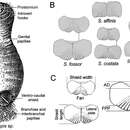Description
provided by Zookeys
Neotype (USNM 15543) complete, most body papillae eroded but transverse rows still noticeable; introvert exposed (Fig. 9C); 9.7 mm long, 3.5 mm wide, 31 segments. Body colour in alcohol often tan to light brown, sometimes ashen or cinereous (Fig. 9A, C). Cuticular papillae evenly distributed over most of the body especially posteriorly, starting at segment 8. Single transverse dorsal rows of clusters of papillae per segment, especially towards posterior end. First seven segments usually much cleaner and translucent, especially in smaller individuals. Body up to 15 mm long, 8 mm wide, about 31 segments.
Prostomium hemispherical, opalescent, without eyespots, minutely granular in appearance. Peristomium rounded, without papillae, slightly raised near mouth. Mouth slightly oval, completely covered by papillae, extends from prostomium almost to edge of segment 2.
First three chaetigers with 6–12 bronze, widely separated, slightly falcate hooks per ramus, with subdistal dark areas, transparent in juveniles, opaque in larger specimens (Fig. 9C). Genital papillae protrude ventrally from intersegmental groove between segments 7 and 8. Pre-shield region with 7 segments, with small, short fascicles of fine capillary chaetae protruding laterally from body wall in some small specimens.
Ventro-caudal shield ribbed; juveniles with few concentric lines darker than the background shield colour, often covered by sediment (Fig. 9B), concentric bands better defined in larger specimens (Fig. 9D); suture extended throughout shield. Anterior margins rounded; anterior depression deep; anterior keels not exposed. Lateral margins straight in smaller specimens, curved in larger specimens, expanding posteriorly. Fan slightly projected beyond posterior corners, smooth in juveniles, crenulated in larger specimens, with a median shallow notch (Figs 1B, 9B).
Marginal chaetal fascicles include 10 lateral ones, chaetae in an oval arrangement, and 6–7 posterior fascicles, chaetae arranged in an approximately ventro-dorsal line. Lateral chaetae light bronze proximally along the shafts, grading to almost clear at the distal ends. Peg chaetae short, often obscured by adhered sediment or filamentous papillae among bases of chaetae. Additional short delicate capillary chaetae between peg chaetae and first posterior fascicle of shield chaetae.
Branchiae stout, coiled, protruding from two oval, obliquely set plates, one on either side of anus. Many long filamentous interbranchial papillae with sediment particles attached.
- license
- cc-by-3.0
- copyright
- Kelly Sendall, Sergio I. Salazar-Vallejo
- bibliographic citation
- Sendall K, Salazar-Vallejo S (2013) Revision of Sternaspis Otto, 1821 (Polychaeta, Sternaspidae) ZooKeys 286: 1–74
- author
- Kelly Sendall
- author
- Sergio I. Salazar-Vallejo
Distribution
provided by Zookeys
Northwestern Atlantic Ocean, from Canada to the northeastern United States coast, in 20–153 m. Other records (Augener 1906: 191, Wesenberg-Lund 1962: 142) need confirmation. The distribution of the true Sternaspis fossor is probably much less extensive than previously thought, and may be confined to the east coast of Canada and northeastern coast of the United States.
- license
- cc-by-3.0
- copyright
- Kelly Sendall, Sergio I. Salazar-Vallejo
- bibliographic citation
- Sendall K, Salazar-Vallejo S (2013) Revision of Sternaspis Otto, 1821 (Polychaeta, Sternaspidae) ZooKeys 286: 1–74
- author
- Kelly Sendall
- author
- Sergio I. Salazar-Vallejo

